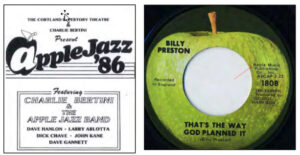1300 19th Street, N.W.
Suite 420 Washington, DC 20036
Bertini v. Apple: N-F-T(acking)?
By Jason Joyal and Brianna Christenson
The Case
Does an Apple loss provide guidance for brand owners seeking to use existing rights in physical goods to enforce against virtual goods? Possibly. On April 4, 2023, the Federal Circuit Court of Appeals decided Bertini v. Apple Inc. The primary issue was tacking, which is the doctrine that allows a mark owner to “tack” the date of first use of an earlier mark onto a later mark if the two marks create the same, continuing commercial impression.
In this case, Apple, the tech-giant, applied to register the mark APPLE MUSIC for several services, including the production and distribution of sound recordings and presenting live musical performances. Apple began using the APPLE MUSIC mark in 2015. Bertini, a jazz musician, has been using the mark APPLE JAZZ since 1985 for “[a]rranging, organizing, conducting, and presenting concerts [and] live musical performances.” Bertini opposed Apple’s application on the grounds that Apple’s use of APPLE MUSIC would cause confusion with Bertini’s prior rights in the APPLE JAZZ mark.

In its defense, Apple argued that it was entitled to a 1968 priority date based on rights to the mark APPLE for “[g]ramaphone records featuring music” and “audio compact discs featuring music” that Apple acquired from the Beatles’ record company in 2007. The Trademark Trial and Appeal Board agreed and dismissed Bertini’s opposition on the grounds that Apple established priority through tacking. The Federal Circuit, however, reversed and held that a new use can only be tacked to a prior use if the new goods or services are “within the normal evolution of the previous line of goods or services.” Because the Federal Circuit found that no reasonable person could conclude that gramophone records and live musical performances are substantially identical based on the record before it, it reversed the Board’s dismissal of the opposition.
The Implications
While the Bertini decision did not allow tacking for the services at issue, its holding simultaneously suggests that tacking may be appropriate where a market is modernizing. This may strengthen the rights of mark owners entering the NFT or metaverse space. Indeed, under the reasoning announced by the Federal Circuit, trademark rights for goods sold in the physical world may be able to establish priority for rights in that same mark for that good in the virtual world as a “normal evolution” of the right owner’s use. While this decision arguably narrows the reach of tacking, it may also serve to clarify and pave the way for rights in new, virtual spaces.
Thank you!
Thank you for getting in touch!
We appreciate you contacting us. One of our colleagues will get back in touch with you soon!
Your cookies settings
XThis website stores cookies on your computer. These cookies are used to collect information about how you interact with our website and allow us to remember you. We use this information in order to improve and customize your browsing experience and for analytics and metrics about our visitors both on this website and other media. To find out more about the cookies we use, see our Privacy Policy.
More infoI Agree

